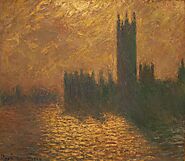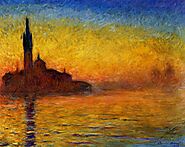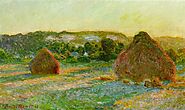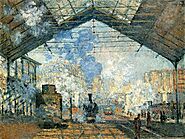-
About
- About Listly
- Community & Support
- Howto
- Chrome Extension
- Bookmarklet
- WordPress Plugin
- Listly Premium
- Privacy
- Terms
- DMCA Copyright
- © 2010-2025 Boomy Labs

 Rosalie Galvez
Rosalie Galvez
Listly by Rosalie Galvez
Ten Most Popular Paintings by Monet admired globally!
Claude Monet was a Popular 19th-century artist from France. In fact, the influential impressionist movement in art took its name from his painting called Impression, Sunrise.
Monet's artworks numbered well clear of 2000 but we have attempted to make a list of 10 of his most popular paintings.
The Impressionist art movement took its name from Claude Monet's painting titled Impression, Sunrise. The subject of the painting is the port city of Le Havre located in Normandy -- Monet's hometown.
When inquired about what he was going to call the painting, Monet decided that the term impression suited the painting as it did not depict any fine details.
One of the most famous Monet Paintings is Impression, Sunrise 1872.
This painting alongside other works of art was displayed in April 1874 at the earliest exhibition of Impressionism. One of the critics present, Louis Leroy, did not look favorably upon the displays and accused the artists of only painting vague impressions.
Despite being intended as a scathing criticism, the description stuck and actually became the name of this controversial, new movement.
Impression, Sunrise by Claude Monet can be viewed at the majestic Musee Marmottan Monet located in Paris. It is the largest collection of impressionist paintings and contains over 300 works by Monet himself.
Rouen Cathedral, Façade (Sunset) is just one an entire collection based on the Rouen Cathedral. Claude Monet had a habit of repeatedly painting one subject many, many times so that he could depict how colors and lights changed. In fact, he painted the awe-inspiring Rouen Cathedral over 30 times in a period between 1892 and 1893.
To do this, Monet rented an apartment directly overlooking the cathedral. He would start working early in the morning and finish at night. As the days rolled on and the lighting varied, Monet jumped from one canvas to the next. He finished these paintings of the cathedral upon his return to his studio in Giverny.
2 years later in 1895, Monet displayed 20 of his painting from this collection at the renowned Durand-Ruel Gallery located in Paris.
The Rouen Cathedral Series by Monet can be viewed at each of the following museums located in France:
Musee Marmottan Monet in Paris
Musee D'Orsay in Paris
Musée des Beaux-Arts de Rouen in Rouen
Elsewhere in Europe, a painting from this collection can be viewed at the below-listed art museums:
Folkwang Museum, Essen, Germany
National Museum Cardiff, Wales
Beyeler Museum, Riehen, Switzerland
In the US, the following art museums own one of the Rouen Cathedral paintings:
J. Paul Getty Museum, Los Angeles
Clark Art Institute, Williamstown
National Gallery of Art, Washington D.C.
Monet's paintings usually had landscapes as their subject. However, every once in awhile, he would paint humans also. Monet painted the 2 people closest to him in this painting namely his spouse Camille and their son Jean, aged 8 at the time. Monet broke away from convention here too as he decided to paint them having a stroll instead of in a conventionally used pose for portraits.
Despite the fact that this sitting could have taken several hours, the final result looks as if an impressionist snapshot of a particular instant had been captured. Monet makes the viewer feel as if the family had gone out for a stroll but had to be interrupted for a photograph.
The painting can be viewed at the National Gallery of Art in Washington, DC.

First in 1900 and then 1901, Monet twice visited London so that he could work on his next series, Houses of Parliament. In total, he painted 19 canvases. Monet decided that a terrace in the St. Thomas Hospital was the optimal spot for his new painting studio.
Monet traveled twice to London to work on the Houses of Parliament series, in 1900 and 1901. Monet painted 19 canvases in total. To get this view, Monet set up a painting studio on a terrace in the St. Thomas Hospital.
Every painting in the series is unique in its own. Each portrays the subject at a unique time of day, and in unique lighting as well as weather. As light tends to change very suddenly in London, Monet would occasionally draw the building beforehand on multiple canvases. He then proceeded to paint whatever he would see whilst looking out from the balcony. As the day went on, Monet again painted on a different canvas to capture the new colors and lighting. Incredibly, he even managed to capture the London fog on his canvases.
These paintings, however, were not finished entirely in London. Instead, he took them back to his painting studio which was Giverny. Scholars could even figure out where exactly Monet painted from, right down to which room and which terrace, based on clues from his paintings.
This is a list of art museums which can boast having one from the collection in their exhibits:
Art Institute of Chicago
Brooklyn Museum
Metropolitan Museum of Art
Musée d'Orsay
Museum of modern art André Malraux – MuMa
Museum of Fine Arts, St. Petersburg

This classic was painted by Claude Monet when he visited Venice with his wife in 1908. This was to be their first and only visit there. The unique aesthetics of the city instantly enchanted Monet's heart to such an extent that Monet thought it was impossible to do justice to it and accurately depict it in his work. In spite of his initially being reluctant to do so, Monet ended up painting some of his most popular works there.
Monet got a hotel room with a view of San Giorgio Maggiore. This is where he captured the majestic sunset that had the famed church on the island in the distance. Monet used live shades of red, yellow, and blue to depict the vibrant sky at sunset and its reflection in the lake below.
National Museum, Cardiff in Wales owns the painting.
From his hotel room, Monet had a view of San Giorgio Maggiore. It was from here that he captured this stunning sunset with the famous island church in the background. Monet used vibrant blues, yellows, and reds to capture the colorful sunset skies and the mirror reflection in the lagoon waters.
The painting is owned by National Museum Cardiff in Wales.
Monet's Water Lilies are widely acknowledged as the most popular painting by Monet ever. However, we often overlook the fact that when we discuss those we are actually referring to 250 separate canvases.
The last 3 decades of Monet's life were spent capturing water lilies. His inspiration was the pond with water lilies in his garden at his home in Giverny. Monet had an obsession with these waterlilies and he would paint them repeatedly, over and over again.
He did not however just recreate the same painting multiple times; he painted them in different conditions such as different lighting, seasons, weather, and at varying times of the day.
These classic Water Lillies by Claude Monet have spread across museums all across the globe and are known as his most popular works.
The most iconic and panels of Water Lilies can be visited at Musee L'Orangerie, which is located in Paris.

Claude Monet worked on another series between 1890 and 1891. This included 25 canvases with haystacks as their subject. These works depict haystacks after they had been harvested in farms around Giverny. As he usually did, Monet once more attempted to capture the same subject in various different settings. He painted them in varying lights, seasons, and colors.
The biggest Haystacks collections are displayed at the Musée d'Orsay and Musée Marmottan Monet in Paris.
Other museums displaying the popular Monet Haystack paintings are:
Art Institute of Chicago
Museum of Fine Arts, Boston
The Metropolitan Museum and Museum of Modern Art in New York
National Museum of Western Art in Tokyo
Musée de l'Orangerie in Paris
Art Institute of Chicago owns six of the twenty-five Haystacks
Minneapolis Institute of Arts
Tel Aviv Museum of Art
Shelburne Museum, Vermont

As well as being a genius painter, Monet was also an avid gardener. This was his escape from his usual occupations. He himself designed the garden at his home, aiming to ensure that it would be colorful in every season and at every point of the year. He included a gorgeous waterlily pond with a Japanese bridge going over it.
Monet was a massive fan of his gardens. So much so that they inspired much of his creative work later in his life. Monet painted a total of 40+ editions of the Japanese Bridge over a Pond of Water Lilies. These works are a part of his popular Water Lilies series.
Art museums showcasing a Claude Monet Japanese Bridge Painting, include:
Musee D'Orsay in Paris
Marmottan Monet Museum, Paris
Pushkin State Museum of Fine Arts
National Gallery of Art, Washington
Princeton University Art Museum
Metropolitan Museum of Art
Philadelphia Museum of Art
Claude Monet Japanese Bridge Painting (public domain)

Claude Monet lived in Argenteuil, a rural settlement a small distance from Paris for some time. This is when he painted The Saint-Lazare Station. On a commute to Paris, he decided to go by train and reached the Saint-Lazare station. Trains had recently come to the fore as a new means of public transit. This train station was a sign of modernity and the industrialization and progress which accompanied it.
Early in 1877, Monet began work on yet another series. This time he chose The Saint-Lazare Station as his muse. Monet was fascinated by the steam engines. His paintings depicted steam being blown into the air from the station. The steam obscures all other features in the background.
These works were displayed at the exhibit known as the 3rd Impressionist Exhibition in April of 1877. However, they were not well-received in the art community. It is a different story today though. They are now one of the most recognizable works of Claude Monet and seen as a powerful representation of the industrial revolution.
This is a list of museums which have a painting from the series:
Musee D'Orsay, Paris
Fogg Art Museum, USA
Chicago Institute of Art
National Gallery, London
Musée Marmottan Monet, Paris
Pola Museum of Art, Japan
Lower Saxony State Museum, Hanover
Würth Collection, Rome
Read full article here
